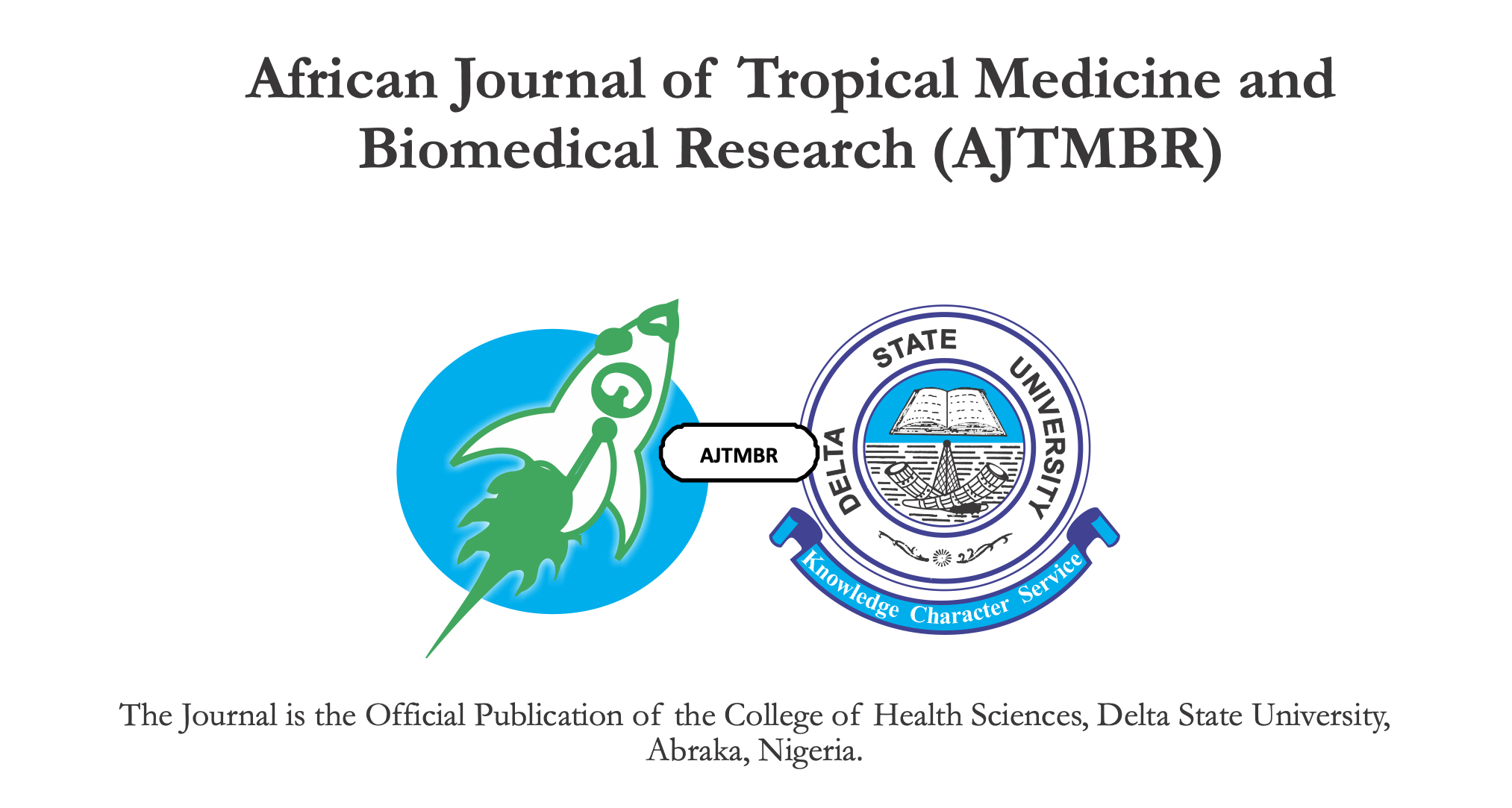Musculoskeletal Manifestations of Rickets:
An Eighteen-Month Observational Study
Keywords:
angular knee deformityAbstract
Objectives: to determine the pattern of presentation of musculoskeletal features of rickets in a large urban health care facility.
Study design: prospective
Setting: University of Benin Teaching Hospital, Orthopaedic Unit.
Subjects: Children aged 16 or less who present at the out-patient clinic with features of rickets.
Outcome measurements: Age at presentation, sex, type of angular knee deformity, time of onset of angular knee deformity, family history of knee deformity, weight, height, body mass index (BMI), serum calcium, serum phosphate and serum alkaline phosphatase levels.
Results: Thirty seven (37) patients aged between birth and 16 years with clinical and radiological evidence of rickets were evaluated during the study period. The mean age at presentation was 3.7±2.08 years and the male: female ratio was 2.4:1 (26 male and 11 female). Windswept deformity was found to be the commonest mode of presentation in our environment, making up 51.4% of all cases seen.
Conclusion: Rickets is a relatively common cause of angular deformity of the knee. In this environment, it is commoner in males and windswept deformity of the knees is the commonest mode of presentation.
References
Louis Solomon. Metabolic and Endocrine
disorders. In: Louis Solomon, David Warwick, Selvadurai Nayagam Authors. Apley's system of orthopaedics and fractures. 9th ed. London: Hodder Arnold; 2010. p.135- 36.
Bafor A, Ogbemudia AO, Umebese PFA. Epidemiology of angular deformities of the knee in children in Benin. Sahel Medical Journal Vol. 11 No.4 October – December 2008): 114-117.
Salawu SAI. Knock knees and bow legs in Zaria. Orient Journal of Medicine. 1992;4:69- 72.
Johan Van Hespen. Body Mass Index Calculator. 1998;[1 screen]. Available at http://www.tn.utwente.nl. Accessed on 9th June 2005.
OyemadeGAA.AetiologicalfactorsinGenu Valga, Vara and Varovalga in Nigerian children. Environmental Child Health. 1975; 167- 172.
Solagberu BA. Angular deformities of the knee in children. Nigerian Journal of Surgical Research. 2000;2:62-67.
Akpede GO, Omotara BA, Ambe JP. Rickets and deprivation: A Nigerian study. J R Soc Promotion Health. 1999;119:216-222.
Hollis BW, Roos BA, Draper HH, Lambert PW. Vitamin D and its metabolites in human and bovine milk. J Nutr 1981; 111:1240-1248.
Reeve LE, Chesney RW, Deluca HF, Vitamin D of human milk: identification of biologically active forms. Am J Clin Nutr. 1982; 36:122-126.
Bachrach S, Fisher J, Parks JS. An outbreak of vitamin D deficiency rickets in a susceptible population. Paediatrics. 1979;64:871-877.
Edidin DV, Levitsky LL, Schey W, Dumbuvic N, Campos A. Resurgence of nutritional rickets associated with breastfeeding and special dietary practices. Paediatrics. 1980;65:232-235.
Rudolf M, Arulanantham K, Greenstein RM. Unsuspected nutritional rickets. Paediatrics. 1980;66:72-76.
Biser-Rohrbaugh A, Hadley-Miller N. Vitamin D deficiency in breastfed toddlers. J Pediatr Orthop. 2001;21:508-511.
Oginni LM, Worsfold M, Oyelami OA, Sharp CA, Powell DE, Davie MWJ. Etiology of rickets in Nigerian children. J Paed. 1996:128(5);692-94.
Okonofua F, Gill DS, Alabi ZO, Thomas M, Bell JL, Dandona P. Rickets in Nigerian Children: a consequence of calcium malnutrition. Metabolism 1991;40:209-13.
Oginni LM, Sharp CA, Badru OS, Risteli J, Davie MWJ, Worsfold M. Radiological and biochemical resolution of nutritional rickets with calcium. Arch Dis Child 2003;88:812- 817.
Oginni LM, Sharp CA, Worsfold M et al. Healing of rickets after calcium supplementation. Lancet. 1999; 353:296- 297.
Fisher PR, Rahman A, Cimma JP, Kyaw- Myint TO, Kabir AR, Talukder K et al. Nutritional rickets without vitamin D deficiency in Bangladesh. J Trop Pediatr.
;45:291-293.
Pettifor JM, Ross P, Wang J, Moodley G, Couper-Smith J. Rickets in children of rural origin in South Africa: is low dietary calcium a factor? J Pediatr. 1978;92:320-324.
Salenius P, Vankka E. The development of the tibiofemoral angle in children. J Bone Joint Surg [Am] 1975; 57:259-261.
Cheng JCY, Chan PS, Chiang SC, Hui PW. Angular and rotational profile of the lower limb in 2,630 Chinese children. J Pediatr Orthop. 1991;11:154-161.
Omololu B, Tella A, Ogunlade SO, Adeyemo AA, Adebisi A, Alonge TO, Salawu SA, Akinpelu AO. Normal values of the knee angle, intercondylar and intermalleolar distances in Nigerian children. West Afr J Med. 2003; 22:301-304.
Heath CH, Staheli LT. Normal limits of the knee angle in white children-Genu varum and genu valgum. J Pediatr Orthop. 1993; 13:259- 262.
Bafor A, Omota B, Ogbemudia AO. Correlation between clinical tibiofemoral angle and body mass index in normal Nigerian children. International Orthopaedics. 2012; DOI 10.1007/s00264- 011-1451-z.

Downloads
Published
Issue
Section
License

This work is licensed under a Creative Commons Attribution-NoDerivatives 4.0 International License.
Key Terms:
- Attribution: You must give appropriate credit to the original creator.
- NonCommercial: You may not use the material for commercial purposes.
- ShareAlike: If you remix, transform, or build upon the material, you must distribute your contributions under the same license as the original.
- No additional restrictions: You may not apply legal terms or technological measures that legally restrict others from doing anything the license permits.
For full details, please review the Complete License Terms.



